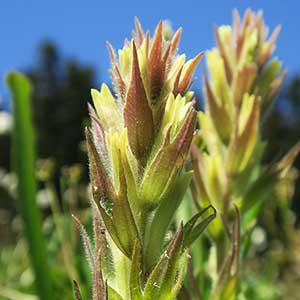Castilleja cryptantha
Castilleja hololeuca
Mt. Rainier or obscure paintbrush, obscure Indian paintbrush, obscure paintbrush
Channel Islands paintbrush, island paintbrush, island white-felted paintbrush, white-felted paintbrush
few to several, erect or ascending, unbranched, hairs spreading, long, soft, eglandular, mixed with short stipitate-glandular ones.
many, erect to spreading, much-branched with many short axillary shoots, proximal stems reaching 1+ cm wide, white-felted, hairs dense, spreading to ± appressed, intertwined, long, soft, slightly branched, obscuring surface.
green, often with brown or purple veins, narrowly to broadly lanceolate, 1.5–4 cm, not fleshy, margins plane, ± involute, 0–3-lobed, apex acute to acuminate;
lobes spreading-ascending, narrowly lanceolate, apex acute to ± obtuse.
ash gray, leaves of previous year persisting on proximal stem, linear, older leaves sometimes broadly linear, 1–5 cm, not fleshy, margins plane, involute, 0-lobed, apex obtuse;
lobes ascending, linear-lanceolate, apex obtuse to rounded, sometimes acute.
(2.5–)3–6 × 1–2 cm; green to dull brown or dull reddish purple throughout, or proximally green to dull brown or dull reddish purple, distally yellow on apices, broadly lanceolate to ovate, (0–)3-lobed;
lobes ascending, narrowly lanceolate, long or short, arising near mid length, apex acute or acuminate.
3–16 × 2–4 cm;
bracts pale gray-green throughout, or proximally pale gray-green, distally red or yellow, proximal linear, distal broader, often oblanceolate to obovate, (0–)3-lobed;
lobes spreading, linear to oblong, short to long, arising below mid length, apex rounded to truncate or acute.
straight, 14–16 mm;
tube 11–14 mm;
whole corolla included within calyx;
beak adaxially pale yellow, 1–2 mm;
abaxial lip deep green, slightly inflated, 4–5 mm, 67% as long as beak;
teeth ascending, pale, 1.5–2 mm.
slightly curved in proximal 1/3, 14–26(–31) mm;
tube 9–17 mm;
abaxial lip not exserted, beak exserted;
beak adaxially green to yellowish, 11–14 mm;
abaxial lip ascending, deep green, reduced, 2–3 mm, less than 33% as long as beak;
teeth reduced to apiculations, deep green, 1–1.5 mm.
proximally green or pale with green veins, lobes yellow, sometimes becoming deep red with age, 12–15 mm;
abaxial and adaxial clefts 3–7 mm, 25–50% of calyx length, deeper than laterals, lateral 1–3(–4) mm, 8–20% of calyx length;
lobes triangular, adaxial segments longer than abaxials, apex acute or obtuse.
colored as bracts, with conspicuous whitish veins, 14–18(–20) mm;
abaxial and adaxial clefts 5–12 mm, 30–67% of calyx length, deeper than laterals, lateral 0 mm or nearly so, ca. 0% of calyx length;
lobes linear-lanceolate, apex rounded, truncate, or emarginate.
= 24.
Castilleja cryptantha
Castilleja hololeuca
Castilleja cryptantha is endemic to the vicinity of Mt. Rainier in the Cascade Range, with most populations found within Mt. Rainier National Park. Unlike most species of Castilleja, it is apparently self-pollinating (W. J. Duffield 1972); the small flowers are entirely enclosed within the yellowish calyces, which tend to grow deep reddish as they age. The purplish brown bracts are also unusual in the genus.
(Discussion copyrighted by Flora of North America; reprinted with permission.)
Castilleja hololeuca is endemic to the four major islands of the northern Channel Islands. It is similar to C. lanata, a mostly Mexican species that reaches Arizona, New Mexico, and southwest Texas. However, C. hololeuca appears to be more closely related to C. foliolosa, a species of the California mainland. These three species, and C. galehintoniae G. L. Nesom of Nuevo León, all share a distinctive, thick indument of pale, matted, and often branched hairs on the stems and leaves. Large individuals of C. hololeuca form thick, woody trunks. On Anacapa Island, closest to the mainland, red-flowered forms of C. hololeuca predominate. On Santa Cruz Island, to the west, both red- and yellow-bracted forms are fairly common, usually in separate populations. Further offshore, on San Miguel and Santa Rosa islands, most plants are yellow to, occasionally, peach in coloration. Reports of this species from Santa Barbara and Santa Catalina Islands are referable to other species, mostly C. foliolosa. Populations of C. hololeuca historically declined from grazing by introduced game and livestock species. The plants are recovering well, following removal of the grazing animals, and are now common in many areas, especially on San Miguel Island.
(Discussion copyrighted by Flora of North America; reprinted with permission.)


